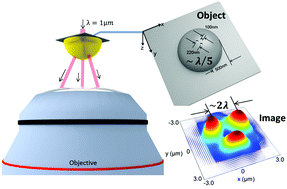Hyperlensing at NIR frequencies using a hemispherical metallic nanowire lens in a sea-urchin geometry†
Abstract
Label-free and real time far-field super-resolution imaging (hyperlensing) at the nanoscale is of significant interest where sub-λ imaging remains a constraint because of Abbe's diffraction limit. Though by utilizing anisotropic permittivities, metal-dielectric multilayers have been successful in reconstructing high-frequency components of sub-λ objects, yet they remain cumbersome and expensive to make. Most of the multilayer structures require multiple vacuum deposition cycles and are plagued by stringent requirements on the surface roughness of metallic layers. In contrast to the multilayer structure here we propose a 3D hyperbolic metamaterial model composed of metallic nanorods arranged in a sea-urchin geometry as a hyper-lensing device, which is capable of projecting and magnifying diffraction limited information into the far-field at Near-infrared (NIR) frequencies. The hyperlens generates a band of flat hyperbolic dispersions in spherical coordinates, which in turn supports the propagation of high wave-vector spatial harmonics leading to far-field super-resolution imaging. Using full-wave finite-difference time-domain (FDTD) simulations with diffraction limited trimer, quadrumer and ringed objects etched on thin perfect electric conductor (PEC) films, we show that the hyperlens model can achieve magnification factors of up to 10× in the far-field (∼4.5λ from the object's surface) under a light source with a wavelength of 1 μm, with successful resolution down to 220 nm (∼λ/5). The magnified image field distribution projected into the far-field is shown to follow the object under a reduction in the symmetry. These results are important for making progress in the realization of real-time biomolecular imaging systems, eliminating the need for near-field scanning, destructive electron microscopy and various image post-processing techniques.


 Please wait while we load your content...
Please wait while we load your content...